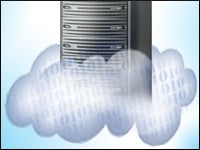 |
Are computing clouds just fancy roach motels, or, to ask the question bluntly: once data is uploaded to a cloud can it ever be retrieved? Or is the situation analogous to the roach motels where the critters check in, but …never check out?
Top IT managers are worried about exactly this issue. Gregg Fenton, director of emerging platforms in The New York Times Company’s Research and Development group, related that the newspaper is presently eyeballing cloud offerings from Amazon, IBM, Google — all the major players.
The New York Times finds a lot to like about cloud computing — the ability to seamlessly offload traffic to an offsite vendor is a major appeal to an enterprise that, sometimes, finds itself hammered by visitors following breaking news. But, Fenton said, “Each cloud is different. There are no standards. Once you decide to go with one vendor, if you later change your mind and want to shift to another vendor, there is no easy way.”
For his part, Fenton said the lack of portability is not necessarily an instant deal-killer for the New York Times, but other businesses apparently are more skeptical. “Enterprise customers tell us there are significant concerns around data portability,” said Russ Daniels, CTO of Cloud Services Strategy at HP.
Rain Clouds
There are grounds for worry, agreed Jian Zhen, senior director of product management at LogLogic in San Jose, Calif.: “Once you put data in the cloud, you are locked in. There is no doubt about that.”
“Clouds do not make it easy to move data around,” added Kyle Austin, vice president of engineering at TriCipher, a Los Gatos, Calif.-based authentication and security firm.
“People are only really beginning to think about this issue,” said Rod Smith, vice president of emerging technologies at IBM.
Much more so than its desks and offices, data are what really define most businesses. But when the data go up into the cloud, the enterprise, in some respects, relinquishes some control and, at the same time, compatibility and portability issues arise that do not have easy fixes.
Smith sees a silver lining, however: “This goes well beyond cloud, and what will happen is that clouds will become a catalyst for how we think about data exchange.”
Flashback 25 years and many of the early PC applications, just like the mainframe applications of that era, wrote data in proprietary formats. Soon enough, however, software developers agreed on universal file formats — .txt or .rtf for word-processing documents, for instance — and the upshot was that users knew they could shift from one application to another. There might be a sweat cost for, say, transforming every file into .rtf, but at least the path to portability was clear.
Portability
Can the same be said for cloud computing? Not exactly, not unless the user insists on it.
“You need to ask for portability at the very start of your cloud involvement,” HP’s Daniels said. Before putting any data in the cloud, enterprises need answers to key questions:
- Do they have the right to extract their data from the cloud? Businesses should put this in writing to make the right vivid.
- Have they determined the cost of extraction, and do they know this can be surprisingly high, particularly when the terms aren’t set at the front end?
- In what form do data come out and what steps will be required to transform them into formats the business can use?
“These are technical challenges,” Daniels agreed, but he indicated that the technology pretty much has been put in place. The real difficulties and gnawing problems revolve instead around rights and prices — data can be extracted, if you can pay the price.
“Companies don’t think this through,” he said. “If it doesn’t work out and you need to get your data out of the cloud, what’s the process? Some enterprise customers are telling us they won’t move to the cloud precisely because of these issues.”
Bluntly put, IT needs to negotiate what amounts to a pre-nup with all cloud providers. Once that is in place, the enterprise can settle back and enjoy the real benefits that come with cloud computing.
Lack of compatibility, in other words, isn’t a dead-end: It’s merely an obstacle to be hurdled, Daniels said. Do that, and, he added, “This problem is readily seen as tractable. Data can be extracted. The only real question is how and at what cost.”
This story originally appeared in CIOUpdate.com.


